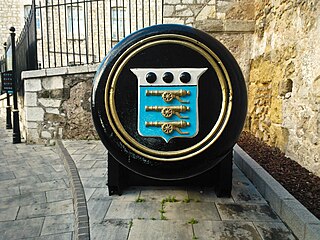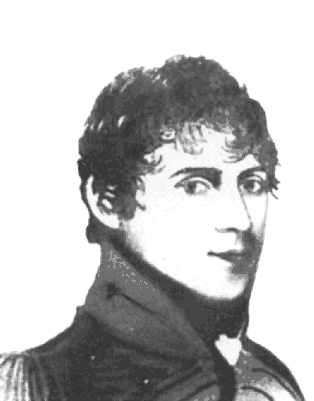An Ammunition Column was a support echelon of a British or Dominion brigade or division during the First World War and consisted of dedicated military vehicles carrying artillery and small arms ammunition for the combatant unit to which the column belonged, generally an Artillery Brigade or a Divisional Artillery.

The Royal Regiment of Artillery, commonly referred to as the Royal Artillery (RA) and colloquially known as "The Gunners", is one of two regiments that make up the artillery arm of the British Army. The Royal Regiment of Artillery comprises thirteen Regular Army regiments, the King's Troop Royal Horse Artillery and five Army Reserve regiments.

The Board of Ordnance was a British government body. Established in the Tudor period, it had its headquarters in the Tower of London. Its primary responsibilities were 'to act as custodian of the lands, depots and forts required for the defence of the realm and its overseas possessions, and as the supplier of munitions and equipment to both the Army and the Navy'. The Board also maintained and directed the Artillery and Engineer corps, which it founded in the 18th century. By the 19th century, the Board of Ordnance was second in size only to HM Treasury among government departments. The Board lasted until 1855, at which point it was disbanded.

"Other ranks" (ORs) is the term used to refer to all ranks below officers in the British Army and the Royal Marines. It includes warrant officers, non-commissioned officers ("NCOs") and ordinary soldiers with the rank of private or regimental equivalent. Officers may, in speaking, distinguish themselves from those "in the ranks".

The Royal Regiment of Australian Artillery, normally referred to as the Royal Australian Artillery (RAA), is a Regiment of the Australian Army descended from the original colonial artillery units prior to Australia's federation. Australia's first guns were landed from HMS Sirius and a small earthen redoubt built, near the present-day Macquarie Place, to command the approaches to Sydney Cove. The deployment of these guns represents the origins of artillery in Australia. These and subsequent defences, as well as field guns, were operated by marines and the soldiers of infantry regiments stationed in Australia. Unlike their British and Canadian equivalents, there are no regiments of horse artillery in the order of battle of the Royal Australian Artillery. The First World War saw the raising of 60 field, 20 howitzer, and two siege batteries along with the heavy and medium trench mortar batteries. Until 19 September 1962 the Australian Artillery was referred to as the 'Royal Australian Artillery', however, on this date Queen Elizabeth II granted the RAA the title of 'The Royal Regiment of Australian Artillery'. The Regiment today consists of Regular and Reserve units.

The Royal Horse Artillery (RHA) was formed in 1793 as a distinct arm of the Royal Regiment of Artillery to provide horse artillery support to the cavalry units of the British Army. Although the cavalry link remained part of its defining character, as early as the Battle of Waterloo the RHA was sometimes deployed more along the lines of conventional field artillery, fighting from comparatively fixed positions.
The Battle of Sanna's Post was an engagement fought during the Second Boer War (1899–1902) between the British Empire and the Boers of the two independent republics of the Orange Free State and the South African Republic.

The Royal Garrison Artillery (RGA) was formed in 1899 as a distinct arm of the British Army's Royal Regiment of Artillery serving alongside the other two arms of the Regiment, the Royal Field Artillery (RFA) and the Royal Horse Artillery (RHA). The RGA were the 'technical' branch of the Royal Artillery who were responsible for much of the professionalisation of technical gunnery that was to occur during the First World War. It was originally established to man the guns of the British Empire's forts and fortresses, including coastal artillery batteries, the heavy gun batteries attached to each infantry division and the guns of the siege artillery. The RGA was amalgamated with the RFA in 1924, from which time the only two arms within the Royal Regiment of Artillery have been the Royal Artillery and the Royal Horse Artillery.
3rd Regiment Royal Horse Artillery is a regiment of the Royal Horse Artillery in the British Army. They are currently based at Albemarle Barracks, Northumberland, England.
XXXVII (Howitzer) Brigade, Royal Field Artillery was a brigade of the Royal Field Artillery which served in the First World War.

General Alexander Cavalié Mercer was a British Army officer of the Royal Horse Artillery. He is most notable as commander of G Troop Royal Horse Artillery at the Battle of Waterloo, and as author of Journal of the Waterloo Campaign.

The Regiment of Artillery is a combat support arm of the Indian Army, which provides massive firepower during all ground operations of the Indian Army. It is a successor to the Royal Indian Artillery (RIA) of British Indian Army, which itself traces its origins to the formation of Bombay Artillery in 1827.
K (Hondeghem) Battery is a battery of 5th Regiment Royal Artillery in the Royal Artillery. It currently serves in the Surveillance and Target Acquisition role and is equipped with Taipan, a type of weapon locating radar.
The 3rd Cavalry Brigade was a cavalry brigade of the British Army. It served in the Napoleonic Wars, in the Boer War, and in the First World War on the Western Front where it was initially assigned to The Cavalry Division before spending most of the war with the 2nd Cavalry Division.
The 1st Cavalry Brigade was a brigade of the British Army. It served in the Napoleonic Wars, the Anglo-Egyptian War, the Boer War and in the First World War when it was assigned to the 1st Cavalry Division.

The 2nd Cavalry Brigade was a brigade of the British Army. It served in the Napoleonic Wars, the Boer War and in the First World War when it was assigned to the 1st Cavalry Division.
I Parachute Battery Royal Horse Artillery is the Headquarters battery of 7th Parachute Regiment Royal Horse Artillery, part of the Royal Horse Artillery of the British Army, currently based in Merville Barracks, Colchester.
V Battery Royal Horse Artillery was a battery of the Royal Horse Artillery. Formed in 1804, the battery took part in the Napoleonic Wars – notably the Peninsular War and Battle of Waterloo – before being placed into suspended animation in 1816 as part of the usual post-war reductions of the British Army.
Social background of officers and other ranks in the British Army, 1750–1815 discusses career paths and social stratification in the British Army from the mid-eighteenth century to the end of the Napoleonic wars. The British army of the period was mainly recruited through volunteer enlistment. Most recruits were young men from the lowest social classes who could not find a livelihood on the civilian labour market. The non-commissioned officers were promoted soldiers sharing the social background of the rank and file. Literacy was a basic requirement for promotion to non-commissioned rank; writing and basic mathematical skills were compulsory for ranks above corporal. About ten percent of the commissioned officers were former sergeants, but the majority came from higher social strata. Aristocracy and gentry were over-represented in the higher ranks, but most officers came from a background of landowners, or were the sons of clergymen, lawyers, doctors or successful merchants. The purchase system was the mechanism through which the officer corps was structured according to social class.









